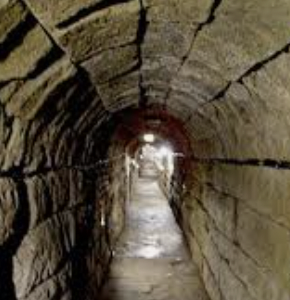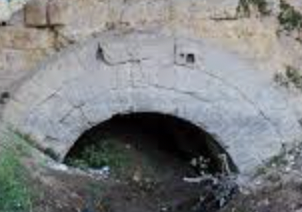
Foundations of an Empire

The Cloaca Maxima, ( Cloaca, Roman goddess), one of the world’s earliest sewage systems and a sacred symbol of Roman culture and Roman engineering, was built during either the Roman Kingdom or the early Roman Republic, around 600 BC, under the orders of the King of Rome, Tarquinius Priscus, to drain local marshes and remove waste from the city to the River Tiber, which ran beside the city.
The sewer started at the Forum Augsutum and ended at the Ponte Rotto and Ponte Palatino, began as an open-air sewer, and some parts of the sewer are still used today.
Before constructing the Cloaca Maxima, Tarquin had to transform the land around and under the Cloaca Maxima from a swampy basin into a solid building ground, and over time this canal was covered up and expanded into a sewer.
Cloaca Maxima sewer system 1, 600 meters long, which started as an open drain which was formed from streams originating from three of the neighboring hills, that was channeled through the main Forum and then on to the Tiber.
The Cloaca Maxima even today drains rainwater and debris from the center of town, below the ancient Forum, Velabrum, and the Forum Boarium. The eleven aqueducts which supplied water to Rome by the 1st century AD were finally channeled into the sewers after having supplied many of the public baths such as Baths of Diocletian and the Baths of Trajan, as well as public fountains, imperial palaces, and private houses.
The continuous supply of running water ensures the removal of wastes and keeps the sewers clear of obstructions. The best waters were reserved for potable drinking supplies, and the second quality waters would be used by the baths, the outfalls of which connected to the sewer network under the streets of the city. The Cloaca Maxima is located below a colonnade being the Forum of Nerva, was built during the reign of Augustus, a vaulted tunnel three meters wide and three meters high, constructed by blocks of red aniene tufa. A part of the sewer near the Temple of Minerva is made of peperino and Opus Caementicium, both sealed with a waterproof seal and a thick layer of pottery.
The Cloaca Maxima was large enough for wagons loaded with hay to pass according to Strabo, enough to transport 100, 000 pounds of waste, unwanted goods dumped into the streets, as well as swamps and rivers near Rome.
The Romans viewed the movement of water to be sacred, the Cloaca Maxima, “ Works for which the new splendour of these days has scarcely been able to produce a match – Titus Livius, Titus Livius, The History of Rome, Book 1.
Anthropologist Mary Douglas claims that the Cloaca Maxima was considered a symbol of the greatness of Rome.
There were many branches of the main sewer, official drains that would have served public toilets, bathhouses, and other public buildings. Private residences in Rome, even of the rich, would have relied on some sort of cess-pit arrangements for sewage. The Sewer started at the Forum Augstum and followed the natural course of the suburbs of ancient Rome which lay between Quirinal, Viminal, and Esquiline Hills and passed the Forum of Neva, the Arch of Janus, the Forum Boarium, the Basilica Aemilia, and the Forum Romanum, ending at the Velabrum. This sewers outfall was by the Ponte Rotto and Ponte Palatino. There is a stairway going down to it visible to the Basilica Julia and the Vicus Tuscus at the Forum and from the surface opposite the church of San Giorgio al Velabro.
